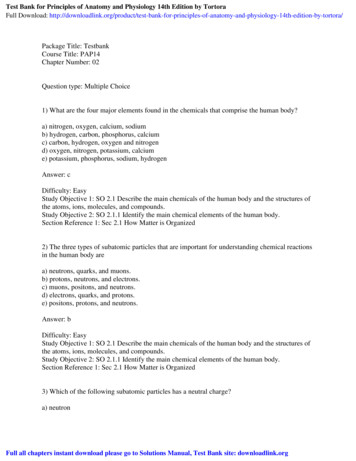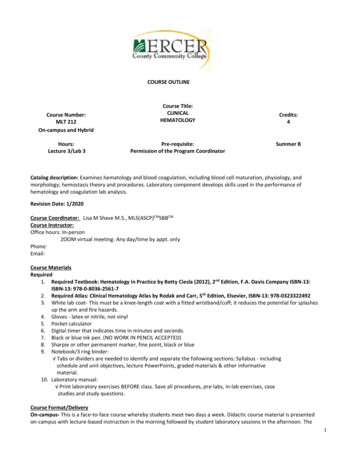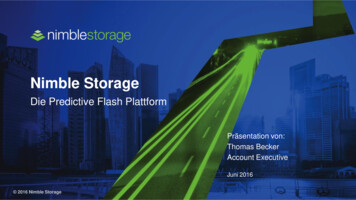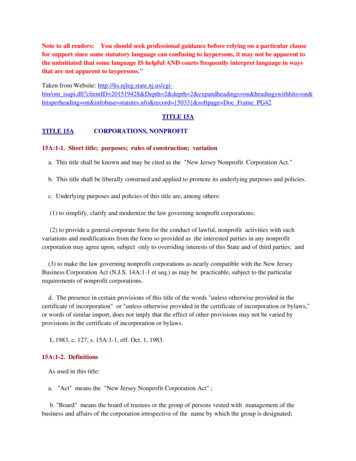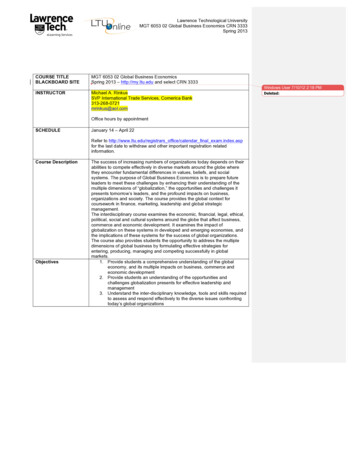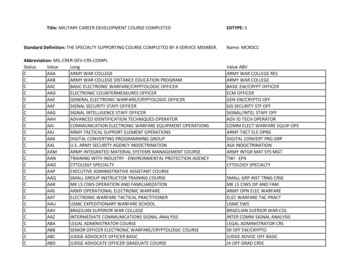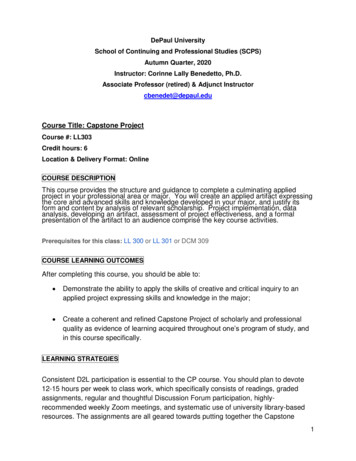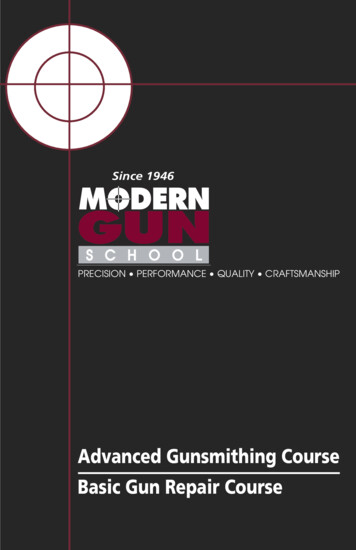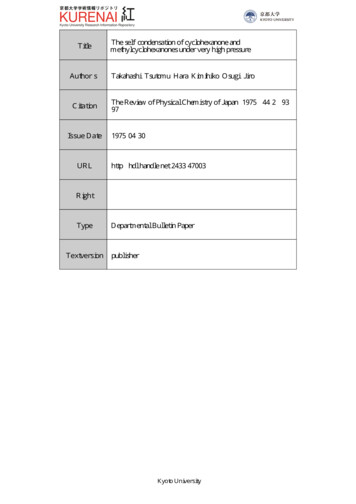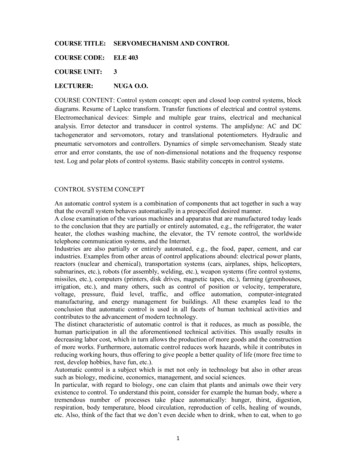
Transcription
COURSE TITLE:SERVOMECHANISM AND CONTROLCOURSE CODE:ELE 403COURSE UNIT:3LECTURER:NUGA O.O.COURSE CONTENT: Control system concept: open and closed loop control systems, blockdiagrams. Resume of Laplce transform. Transfer functions of electrical and control systems.Electromechanical devices: Simple and multiple gear trains, electrical and mechanicalanalysis. Error detector and transducer in control systems. The amplidyne: AC and DCtachogenerator and servomotors, rotary and translational potentiometers. Hydraulic andpneumatic servomotors and controllers. Dynamics of simple servomechanism. Steady stateerror and error constants, the use of non-dimensional notations and the frequency responsetest. Log and polar plots of control systems. Basic stability concepts in control systems.CONTROL SYSTEM CONCEPTAn automatic control system is a combination of components that act together in such a waythat the overall system behaves automatically in a prespecified desired manner.A close examination of the various machines and apparatus that are manufactured today leadsto the conclusion that they are partially or entirely automated, e.g., the refrigerator, the waterheater, the clothes washing machine, the elevator, the TV remote control, the worldwidetelephone communication systems, and the Internet.Industries are also partially or entirely automated, e.g., the food, paper, cement, and carindustries. Examples from other areas of control applications abound: electrical power plants,reactors (nuclear and chemical), transportation systems (cars, airplanes, ships, helicopters,submarines, etc.), robots (for assembly, welding, etc.), weapon systems (fire control systems,missiles, etc.), computers (printers, disk drives, magnetic tapes, etc.), farming (greenhouses,irrigation, etc.), and many others, such as control of position or velocity, temperature,voltage, pressure, fluid level, traffic, and office automation, computer-integratedmanufacturing, and energy management for buildings. All these examples lead to theconclusion that automatic control is used in all facets of human technical activities andcontributes to the advancement of modern technology.The distinct characteristic of automatic control is that it reduces, as much as possible, thehuman participation in all the aforementioned technical activities. This usually results indecreasing labor cost, which in turn allows the production of more goods and the constructionof more works. Furthermore, automatic control reduces work hazards, while it contributes inreducing working hours, thus offering to give people a better quality of life (more free time torest, develop hobbies, have fun, etc.).Automatic control is a subject which is met not only in technology but also in other areassuch as biology, medicine, economics, management, and social sciences.In particular, with regard to biology, one can claim that plants and animals owe their veryexistence to control. To understand this point, consider for example the human body, where atremendous number of processes take place automatically: hunger, thirst, digestion,respiration, body temperature, blood circulation, reproduction of cells, healing of wounds,etc. Also, think of the fact that we don’t even decide when to drink, when to eat, when to go1
to sleep, and when to go to the toilet. Clearly, no form of life could exist if it were not for thenumerous control systems that govern all processes in every living organism.It is important to mention that modern technology has, in certain cases, succeeded inreplacing body organs or mechanisms, as for example in replacing a human hand, cut off atthe wrist, with an artificial hand that can move its fingers automatically, as if it were a naturalhand. Although the use of this artificial hand is usually limited to simple tasks, such asopening a door, lifting an object, and eating, all these functions are a great relief to peoplewho were unfortunate enough to lose a hand.The Basic Structure of A Control SystemA system is a combination of components (appropriately connected to each other) that acttogether in order to perform a certain task. For a system to perform a certain task, it must beexcited by a proper input signal. Figure 1.1 gives a simple view of this concept, along withthe scientific terms and symbols. Note that the response y(t) is also called system’s behavioror performance.Symbolically, the output y(t) is related to the input u(t) by the following equationy(t) Tu(t)1.1where T is an operator. There are three elements involved in Eq. (1.1): the input u(t), thesystem T, and the output y(t). In most engineering problems, we usually know (i.e., we aregiven) two of these three elements and we are asked to find the third one. As a result, thefollowing three basic engineering problems tputeffectFigure 1.1 Schematic diagram of a system with its input and output.1. The analysis problem. Here, we are given the input u(t) and the system T and we areasked to determine the output y(t)2. The synthesis problem. Here, we are given the input u(t) and the output y(t) and weare asked to design the system T.3. The measurement problem. Here, we are given the system T and the output y(t) andwe are asked to measure the input u(t).Control systems can be divided into two categories: the open-loop and the closed-loopsystems.An open-loop system (Figure 1.2a) is a system whose input u(t) does not depend on theoutput y(t), i.e., u(t) is not a function of y(t).A closed-loop system (Figure 1.2b) is a system whose input u(t) depends on the output y(t),i.e., u(t) is a function of y(t).2
ystemy(t)(b)Figure 1.2 Two types of systems: (a) open-loop system; (b) closed-loop system.In control systems, the control signal u(t) is not the output of a signal generator, but theoutput of another new additional component that is added to the system under control. Thisnew component is called controller (and in special cases regulator or compensator).Furthermore, in control systems, the controller is excited by an external signal r(t), which iscalled the reference or command signal. This reference signal r(t) specifies the desiredperformance (i.e., the desired output y(t)) of the open- or closed-loop system. That is, incontrol systems, we aim to design an appropriate controller such that the output y(t) followsthe command signal r(t) as close as possible. In particular, in open-loop systems (Figure 1.2a)the controller is excited only by the reference signal r(t) and it is designed such that its outputu(t) is the appropriate input signal to the system under control, which in turn will produce thedesired output y(t). In closed-loop systems (Figure 1.2b), the controller is excited not only byreference signal r(t) but also by the output y(t). Therefore, in this case the control signal u(t)depends on both r(t) and y(t). To facilitate better understanding of the operation of open-loopand closed-loop systems the following introductory examples is presented ashing e 1.3 The clothes washing machine as an open-loop system.A very simple introductory example of an open-loop system is that of the clothes washingmachine (Figure 1.3). Here, the reference signal r(t) designates the various operatingconditions that we set on the ‘‘programmer,’’ such as water temperature, duration of variouswashing cycles, duration of clothes wringing, etc. These operating conditions are carefullychosen so as to achieve satisfactory clothes washing.The controller is the ‘‘programmer,’’ whose output u(t) is the control signal. This controlsignal is the input to the washing machine and forces the washing machine to execute thedesired operations assigned in the reference signal r(t), i.e., water heating, water changing,clothes wringing, etc. The output of the system y(t) is the ‘‘quality’’ of washing, i.e., howwell the clothes have been washed. It is well known that during the operation of the washingmachine, the output (i.e., whether the clothes are well washed or not) it not taken intoconsideration. The washing machine performs only a series of operations contained in u(t)without being influenced at all by y(t). It is clear that here u(t) is not a function of y(t) and,3
therefore, the washing machine is a typical example of an open-loop system. Other examplesof open-loop systems are the electric stove, the alarm clock, the elevator, the traffic lights, theworldwide telephone communication system, the computer, and the Internet.A very simple introductory example of a closed-loop system is that of the water heater(Figure 1.4). Here, the system is the water heater and the output y(t) is the water temperature.The reference signal r(t) designates the desired range of the water temperature. Let thisdesired temperature lie in the range from 65 to 70oC. In this example, the water is heated byelectric power, i.e., by a resistor that is supplied by an electric current. The controller of thesystem is a thermostat, which works as a switch as follows: when the temperature of thewater reaches 70oC, the switch opens and the electric supply is interrupted. As a result, thewater temperature starts falling and when it reaches 65oC, the switch closes and the electricsupply is back on again. Subsequently, the water temperature rises again to 70oC, the switchopens again, and so on. This procedure is continuously repeated, keeping the temperature ofthe water in the desired temperature range, i.e., between 65 and 70oC.A careful examination of the water heater example shows that the controller (the thermostat)provides the appropriate input u(t) to the water heater. Clearly, this input u(t) is decisivelyaffected by the output y(t), i.e., u(t) is a function of not only of r(t) but also of y(t). Therefore,here we have a typical example of a closed-loop system.Other examples of closed-loop systems are the refrigerator, the voltage control system, theliquid-level control system, the position regulator, the speed regulator, the nuclear reactorcontrol system, the robot, and the guided aircraft. All these closed-loop systems operate bythe same principles as the water heater presented above.It is remarked that in cases where a system is not entirely automated, man may act as thecontroller or as part of the controller, as for example in driving, walking, and cooking. Indriving, the car is the system and the system’s output is the course and/or the speed of the car.The driver controls the behavior of the car and reacts accordingly: he steps on the acceleratorif the car is going too slow or turns the steering wheel if he wants to go left or right.Therefore, one may argue that driving a car has the structure of a closed-loop system, wherethe driver is the controller.Similar remarks hold when we walk. When we cook, we check the food in the oven andappropriately adjust the heat intensity. In this case, the cook is the controller of the closedloop ater ure 1.6 The water heater as a closed-loop system.From the above examples it is obvious that closed-loop systems differ from open-loopsystems, the difference being whether or not information concerning the system’s output isfed back to the system’s input. This action is called feedback and plays the most fundamentalrole in automatic control systems.4
THE LAPLACE TRANSFORMTo study and design control systems, one relies to a great extent on a set of mathematicaltools. These mathematical tools, an example of which is the Laplace transform, facilitate theengineer’s work in understanding the problems he deals with as well as solving them.For the special case of linear time-invariant continuous time systems, which is the mainsubject of the book, the Laplace transform is a very important mathematical tool for the studyand design of such systems. The Laplace transform is a special case of the generalizedintegral transform presented below.Figure 2.1 The sinusoidal functionIntroduction to Laplace TransformThe Laplace transform is a linear integral transform with kernel k(s, t) e-st and time interval(0,1). Therefore, the definition of the Laplace transform of a function f (t) is as follows:where L designates the Laplace transform and s is the complex variable defined as. Usually, the time function f (t) is written with a small f, while the complexvariable function F(s) is written with a capital F.For the integral to converge, f (t) must satisfy the condition Where σ and M are finite positive numbers.Let. Then, the inverse Laplace transform of F(s) is also a linear integraltransform, defined as follows:12where L-1 designates the inverse Laplace transform, 1, and c is a complex constant.Properties and Theorems of the Laplace TransformThe most important properties and theorems of the Laplace transform are presented below.1. Linearity2. The Laplace Transform of the Derivative of a Function5
3. The Laplace Transform of the Integral of a Function4. Time Scaling5. Shift in the Frequency Domain6. Shift in the Time Domain7. The Initial Value Theorem8. The Final Value Theorem9. Multiplication of a Function by t10. Division of a Function by t11. Periodic FunctionsAPPLICATIONS OF THE LAPLACE TRANSFORMThis section presents certain applications of the Laplace transform in the study of linearsystems.Example 1Determine the voltage across the capacitor of the circuit shown in Figure 2.2. The switch Scloses when t 0. The initial condition for the voltage capacitor is zero, i.e.Vc (0) 0.Figure 2.2 RC networkSolutionFrom Kirchhoff’s voltage law we have1 Applying the Laplace transform to both sides of the integral equation, we get the followingalgebraic equation10Where I(s) L{i(t)} andabove equation, we haveor000. Replacing The inverse laplace transform of I(s) is as follows Hence, the vo
voltage, pressure, fluid level, traffic, and office automation, computer-integrated manufacturing, and energy management for buildings. All these examples lead to the conclusion that automatic control is used in all facets of human technical activities and contributes to the advancement of modern technology.

